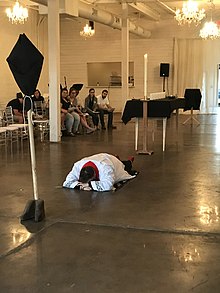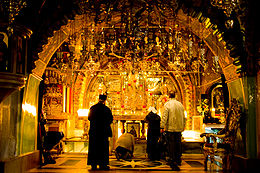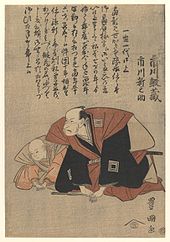Prostration


Prostrationis thegestureof placing one's body in areverentiallyorsubmissivelyprone position.Typically prostration is distinguished from the lesser acts ofbowingorkneelingby involving a part of the body above the knee, especially the hands, touching the ground.
Major worldreligionsemploy prostration as an act of submissiveness orworshipto asupreme being or other worshiped entity (i.e. God),as in themetanoiainChristian prayerused in theEastern OrthodoxandOriental Orthodox Churchesand thesujudof theIslamicprayer,salat.[1]In various cultures and traditions, prostrations are similarly used to show respect to rulers, civil authorities and social elders or superiors, as in theChinesekowtoworAncient Greekproskynesis.The act has often traditionally been an important part of religious, civil and traditional rituals and ceremonies, and remains in use in many cultures.
Traditional religious practices[edit]

Many religious institutions (listed Alpha betically below) use prostrations to embody the lowering, submitting or relinquishing of the individual ego before a greater spiritual power or presence.
Baháʼí Faith[edit]
In theBaháʼí Faith,prostrations are performed as a part of one of the alternatives of obligatory prayer (the "Long" one)[2]and in the case of traveling, a prostration is performed in place of each missedobligatory prayerin addition to saying "Glorified be God, the Lord of Might and Majesty, of Grace and Bounty". However, if unable to do so, saying "Glorified be God" is sufficient.[3]There are specifics about where the prostration can take place including, "God hath granted you leave to prostrate yourselves on any surface that is clean..." (note #10) and "He also condemns such practices as prostrating oneself before another person and other forms of behaviour that abase one individual in relation to another". (note #57)
Buddhism[edit]
InBuddhism,prostrations are commonly used and the various stages of the physical movement are traditionally counted in threes and related to theTriple Gem,consisting of:
- the Awakened One (Sanskrit/Pali:Buddha) (in this meaning, to own potential)
- his teaching (Sanskrit:Dharma;Pali:Dhamma)
- his community (Sangha) of noble disciples (ariya-savaka).[4]
In addition, different schools within Buddhism use prostrations in various ways, such as theTibetantantricpreliminary practice of a 100,000 prostrations as a means of overcoming pride (seeNgöndro).[5]Tibetan pilgrims often progress by prostrating themselves fully at each step, then moving forward as they get up, in such a way that they have lain on their face on each part of their route. Each three paces involves a full prostration; the number three is taken to refer to the Triple Gem. This is often done round astupa,and in an extremely arduous pilgrimage,Mount Kailashis circumnavigated entirely by this method, which takes about four weeks to complete the 52 kilometre route. It is also not unusual to see pilgrims prostrating all the way from their home to Lhasa, sometimes a distance of over 2000 km, the process taking up to two years to complete.
Christianity[edit]

InOriental Orthodox Christianityand Western Orthodox Christianity, believers prostrate during theseven fixed prayer times;prayer rugsare used by some adherents to provide a clean space for believers to offer theirChristian prayersto God, e.g. thecanonical hours.[6][7]Oriental Orthodox Christians, such as Copts, incorporate prostrations in their prayers that are performedfacing eastwardin anticipation of theSecond Coming of Jesus,"prostrating three times in the name of theTrinity;at the end of each Psalm… while saying the ‘Alleluia’; and multiple times "during the forty-oneKyrie eleisons"(cf.Agpeya).[6][1]Syriac OrthodoxandIndian OrthodoxChristians, as well as Christians belonging to theMar Thoma Syrian Church(anOriental Protestantdenomination), make multiple prostrations at the seven fixed prayer times during which the canonical hours are prayed, thrice during the Qauma prayer, at the words "Crucified for us, Have mercy on us!", thrice during the recitation of the Nicene Creed at the words "And was incarnate of the Holy Spirit...", "And was crucified for us...", & "And on the third day rose again...", as well as thrice during the Prayer of the Cherubim while praying the words "Blessed is the glory of the Lord, from His place forever!" (cf.Shehimo).[8][9]Oriental Catholic and Oriental Protestant rites also use prostrations in a similar way as the Oriental Orthodox Churches.[10]
AmongOld Ritualists,a prayer rug known as thePodruchnikis used to keep one's face and hands clean during prostrations, as these parts of the body are used to make thesign of the cross.[11]
TheCatholic,Lutheran,andAnglicanChurches use full prostrations, lying flat on the floor face down, during the imposition ofHoly Orders,[12]Religious Professionand theConsecration of Virgins.Additionally, in the Roman Catholic Church and United Methodist Church, at the beginning of the Good Friday Liturgy, the celebrating priest and the deacon[13]prostrate themselves in front of thealtar.Dominican practice on Good Friday services in priory churches includes prostration by all friars in the aisle of the church. In the Roman Catholic, Lutheran and Anglican churches, partial prostrations ( "profound bows" ) can be used in place ofgenuflectionsfor those who are unable to genuflect. The prostration is always performed before God, and in the case of holy orders, profession or consecration the candidates prostrate themselves in front of the altar which is a symbol of Christ.

InEastern Orthodox(Byzantine Rite) worship, prostrations are preceded by making thesign of the crossand consist of kneeling and touching the head to the floor. They are commonly performed both at specific moments during the services and whenveneratingrelicsoricons.However, prostrations are forbidden on theLord's Day(Sunday) and duringPaschaltide(Easter season) in honour of the Resurrection[14]and are traditionally discouraged onGreat Feastsof the Lord. DuringGreat Lent,andHoly Week,frequent prostrations are prescribed (seePrayer of St. Ephraim). Orthodox Christian may also make prostrations in front of people (though in this case without the Sign of the Cross, as it is not an act of veneration ordivine worship), such as thebishop,one'sspiritual fatheror one another when askingforgiveness(in particular at theVespersservice which beginsGreat Lenton the afternoon of theSunday of Forgiveness.) Those who are physically unable to make full prostrations may instead substitutemetanias(bows at the waist).
Hinduism[edit]
InHinduism,eight-limbed (ashtanga pranama,also calleddandavat,meaning "like a stick" ) and five-limbed (panchanga pranama) prostrations are included in the religious ritual ofpuja.
Islam[edit]

InIslam,prostrations (sajadat,plural ofsujudorsajda) are used to praise, glorify and humble oneself in front ofAllah(The God), and are a vital part of the five obligatoryprayersperformed daily; this is deemed obligatory for everyMuslimwhether the prayers are being performed individually or in the congregation.[15][16][17]Additionally, the thirty-second chapter (sura) of theQur'anis titledAs-Sajdah( "The Prostration": see32:1(TranslatedbyYusuf Ali)), while theArabicwordsujud(also meaning prostration) appears about 90 times in the Qur'an, a fact which many Muslim scholars claim to be another example of its significance in Islam.[17]
According to a traditional account of thewords and deedsofMuhammadas contained in the collection ofhadithofIbn Majah,Muhammad is reported to have said that "The prayer [salah] is a cure for many diseases" and have advised people to perform prostration gracefully.[16]
It is also important to note that in Islam, the prostration to anyone but Allah is absolutely forbidden. Muhammad strictly prohibited Muslims from prostrating before him. Regardless of the circumstances, no Muslim should request or accept prostration from others, as prostration of anyone but Allah is strictly prohibited in Islam.
Jainism[edit]
InJainism,there is a great importance placed on prostration, especially when a devotee is in the temples or in front of high souls.[clarification needed]It represents the surrendering ofego.
Judaism[edit]

InJudaism,theTanakhandTalmudictexts as well as writings ofGaonimandRishonimindicate that prostration was very common among Jewish communities until some point during the Middle Ages. InMishneh Torah,Maimonidesstates full prostration (with one's body pressed flat to the earth) should be practiced at the end of the Amidah, recited thrice daily. Members of theKaraitedenomination practice full prostrations during prayers. Traditionally,OrthodoxAshkenaziJewsprostrated duringRosh HashanaandYom Kippur,as didYemenite Jewsduring theTachanunpart of daily Jewish prayer.Ethiopian Jewstraditionally prostrated during a holiday specific to their community known asSigd.Sigdcomes from aroot wordmeaning prostration inGe'ez,Aramaic,andArabic.There is a movement amongTalmide haRambamto revive prostration as a regular part of daily Jewish worship.
Rabbinical Judaism teaches that when the High Priest spoke theTetragrammatonin the Holy of Holies of the Temple in Jerusalem on Yom Kippur, the people in the courtyard were to prostrate themselves completely as they heard the name spoken aloud.
Judaism forbids prostration directly on a stone surface in order to prevent conflation with similar practices ofCanaanitepolytheists.[18]
Sikhism[edit]
Sikhsprostrate in front ofGuru Granth Sahib,the holy scripture of the Sikhs. Sikhs consider Guru Granth Sahib as their livingGuruand the unchanging word ofGod:thus, by prostrating, Sikhs present their head to their Guru, awaiting command, which is taken in the form of ahukamnama,or a random opening of Guru Granth Sahib to reveal an edict for the individual or congregation (similar to the ancient Roman practice ofsortes sanctorum,a form ofbibliomancy). Sikhs call the prostrationmutha tekna( "lowering the forehead" ). Whenever and however many times a Sikh is in the presence of Guru Granth Sahib he will prostrate, usually upon the initial sight of Guru Granth Sahib and again upon leaving the presence of Guru Granth Sahib. Sikhs, in their personal worship (morningNitnemand eveningRehras), will prostrate upon the completion of prayers and theardās.The direction of prostration is not important as Sikhs place emphasis on theomnipresenceof God: however, if it is possible, Sikhs tend to prostrate in the direction in whichbani(books containing the word of God, such as the Gutka Sahib or Pothi Sahib) are kept. Other prostrations practiced by Sikhs from an Indian culture are touching of the feet to show respect and great humility (generally done to grandparents and other family elders). Full prostration is reserved for Guru Granth Sahib, as prostration is considered to be the ultimate act of physical humility and veneration.
Other contexts[edit]

Outside of traditional religious institutions, prostrations are used to show deference to worldly power, in the pursuit general spiritual advancement and as part of a physical-health regimen.
Hawaii[edit]
Inancient Hawaii,a form of prostration known askapu moerequired all to prostrate in the presence of anīʻaupiʻoor apiʻochief on the pain of death. The only people exempt from this were chiefs of the next grade thenahaandwohichiefs who were required to sit in their presence. Other Polynesian groups are known to practice this.
Imperial China[edit]
InImperial China,a form of prostration known as akowtowor kētou was used as a sign of respect and reverence.
Japan[edit]

InJapan,a common form of prostration is calleddogeza,which was used as a sign of deep respect and submission for the elders of a family, guests,samurai,daimyōsand the Emperor. In modern times, it is generally used only in extreme circumstances, such as when apologizing for very serious transgressions or begging for an incredible favor.
To perform dogeza, a person first enters the sitting/kneeling position known asseiza,and then proceeds to touch the head to the ground. This practice may be related to rites of theShintoreligion andculture of Japandating back centuries.
Martial arts[edit]
Shugyo inmartial arts,particularly in theShōtōkaiandKyokushinstyles ofKarate,it is a form of extremespiritual discipline.
Yoga[edit]
In modernyogapractice, "sun salutations" (sūrya namaskāra) are a regular part of practitioners' routines. Such a practice may be used for both maintaining physical well-being andspiritual attainment.
Yoruba Ìdọ̀bálẹ̀ and Ìkúnlẹ̀[edit]
In traditional and contemporaryYoruba culture,younger male family and community members greet elders by assuming a position called "ìdọ̀bálẹ̀".The traditional, full Yoruba prostration involves the prostrator lying down almost prone with his feet extended behind his torso while the rest of his weight is propped up on both hands. This traditional form is being replaced by a more informal bow and touching the fingertips to the floor in front of an elder with one hand, while bending slightly at the knee. The female form of the greeting is the"ìkúnlẹ̀",a form of kneeling where the younger party bows to one or both knees in front of an elder relative or community member. Both gestures are widely practiced; to not perform them would be considered ill-mannered.
Modified versions of both greetings are also common in traditional Yoruba religious and cultural contexts in theAfrican diaspora,particularly in Brazil and Cuba.
See also[edit]
Notes and references[edit]
- ^abDawood, Bishoy (8 December 2013)."Stand, Bow, Prostrate: The Prayerful Body of Coptic Christianity: Clarion Review".Clarion Review.Retrieved27 July2020.
- ^Bill Washington (1996)."Some Passing Comments on the Long Obligatory Prayer of Bahá'u'lláh".Baháʼí Studies in Australasia.3.Association for Baháʼí Studies Australia.Retrieved30 September2015.
- ^Source: The Kitab-i-Aqdas, The Most Holy Book, by Baha'u'llah, #14.
- ^For an example of how this reverence for the Triple Gem is embodied in thePali Canon,see, e.g., theRatana Sutta.
- ^See the "Namo Buddha Glossary of Buddhist Terminology," entry "four special foundations" ("Namo Buddha Glossary of Buddhist Terminology".Archived fromthe originalon 7 June 2021.Retrieved3 September2008.).
- ^abKosloski, Philip (16 October 2017)."Did you know Muslims pray in a similar way to some Christians?".Aleteia.Retrieved25 July2020.
- ^Bishop Brian J Kennedy, OSB."Importance of the Prayer Rug".St. Finian Orthodox Abbey. Archived fromthe originalon 25 July 2020.Retrieved25 July2020.
- ^Shehimo: Book of Common Prayer.Diocese of South-West America of the Malankara Orthodox Syrian Church.2016. p. 5, 7, 12.
- ^Richards, William Joseph (1908).The Indian Christians of St. Thomas: Otherwise Called the Syrian Christians of Malabar: a Sketch of Their History and an Account of Their Present Condition as Well as a Discussion of the Legend of St. Thomas.Bemrose. p. 99.
- ^Landy, Thomas M. (11 February 2014)."Syro-Malabar Catholics worship eastward".Catholics & Cultures.Retrieved21 August2020.
At Syro-Malabar liturgies, men and women generally separate into different sides of the church. Shoes are left outside of church, and prayer rugs cover the floor.
- ^Basenkov, Vladimir (10 June 2017)."Vladimir Basenkov. Getting To Know the Old Believers: How We Pray".Orthodox Christianity.Retrieved25 July2020.
- ^Latona, Mike (1 August 2022)."Prostration a powerful moment in ordination rites".Catholic Courier.Retrieved12 August2022.
- ^2011 Roman Missal, [Good Friday] paragraph 5
- ^Canon 20of the 1st Ecumenical Council,Canon 90of the 6th Ecumenical Council, Canon 91 of St Basil
- ^"How to Perform Salaah"(PDF).Archived fromthe original(PDF)on 25 February 2009.
- ^abThe Medical Advantages of Sajdah[permanent dead link]- by Dr. Muhammad Karim Beebani
- ^ab"Benefits of Salah".islamawareness.net.
- ^"Do Jews Kneel in Prayer?".chabad.org.
